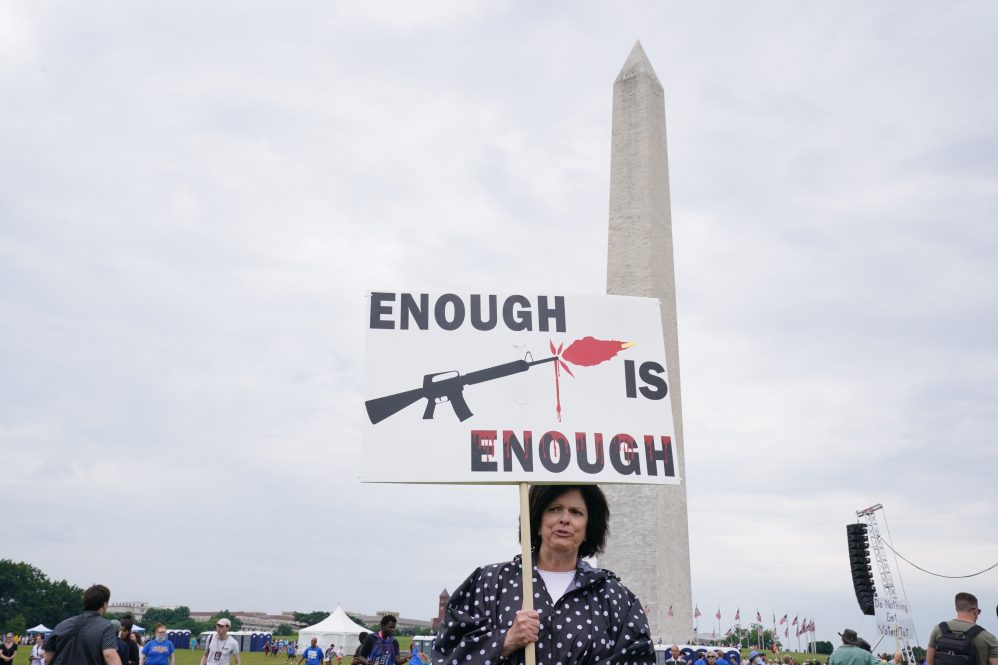The US doesn’t have a gun violence epidemic – it has gun violence epidemics, plural, with wide variation in the types and severity of the problem across states and cities which in turn have a confounding array of regulations and laws in place regarding firearms.
It’s an area of policy which combines public health, constitutional law, and partisan politics, presenting a unique challenge for lawmakers, researchers, health professionals, and members of the public who seek to understand the issues involved.
Now, for the first time, a major American social science journal has devoted a special issue to the unique complexity of gun violence and gun safety, edited by two UConn faculty members along with a colleague at Johns Hopkins University.

The special issue of the ANNALS of the American Academy of Political and Social Science – edited by Kerri Raissian, associate professor in the School of Public Policy; Jennifer Necci Dineen, associate professor in residence in the School of Public Policy; and Cassandra Crifasi, associate professor in the Department of Health Policy and Management at Johns Hopkins – offers up-to-date research examining policies that work to reduce gun violence, as well as policies that don’t. The goal of the journal – access to which is free in perpetuity, a rarity among academic journals – is to suggest ways forward for research, policy, and practice that rely on scholarship and evidence-based reasoning.
“The goal of this issue is not to create more restrictive policies, and the goal of this issue is not to create more permissive policies,” Raissian says. “The goal of this issue, and our scholarship in general, is to reduce gun injury and death, and for some people that may mean owning guns; for some people, that may mean a different way of owning guns; and for some people that may mean not owning guns at all. It’s a continuum.”
Dineen adds: “There are different environments and different needs that require different responses, and that’s what we need to manage through policy and practice that’s rooted in sound scholarship.”
Raissian and Dineen are well-placed to tackle an imposing subject like this. As the respective director and associate director of the UConn ARMS Center (Advancing Research, Methods, and Scholarship in Gun Violence Prevention), part of the Institute for Collaboration on Health, Innovation, and Policy (InCHIP) at UConn, they have been working for years to bring greater scholarly focus on a major problem that is, perhaps surprisingly, relatively unstudied.
“Gun violence scholarship in general has been sort of stymied by a lack of federal research dollars,” Raissian says.
Despite the grim reality that the US has the highest gun death rate of any developed country, with some 45,222 firearm deaths in 2020 alone, for decades the federal government – the principal funder of scientific research in the country – was essentially absent from the field.
A law passed by Congress in 1996 barred the use of federal Centers for Disease Control and Prevention dollars “to advocate or promote gun control,” essentially cutting off funding to researchers in the field. This funding drought continued until 2019, when Congress appropriated $25 million annually to study gun violence prevention – a welcome change, but still significantly smaller than the funding allotted for other health research, such as the $355 million or so spent annually on childhood cancer research, despite gun violence being the leading cause of death for children.

As a result, gun violence is still a subject where some seemingly basic questions remain unanswerable – like the total number of firearms owned by Americans.
“There are some real gaps in the data, and there are real consequences to that,” Raissian says. “When we have conversations with policymakers who ask about long-term trends, sometimes we have to say, ‘I don’t know that we’ll ever be able to know that answer, because investment in research in the past just wasn’t there.’”
Filling those gaps now and in the future is one of the goals of the special issue, which brings together contributions from leading scholars in a variety of fields, who contributed articles on subjects ranging from suicide to mass shootings to social media to law to gun locks to legislation and more.
The process of putting the issue together – which started as an idea shortly before the COVID-19 pandemic threw academic plans, along with everything else, into a prolonged phase of uncertainty – was a lengthy one, involving multiple rounds of drafts, comments, and a two-day conference at UConn Hartford. But the result has been worth it: a first-of-its-kind collection of scholarly articles by some of the most well-known voices in their fields tackling gun violence from the widest possible perspective.
“When we were developing this idea, one thing that really stood out is that it was a truly interdisciplinary project, and also that it does not come from a particular partisan perspective,” Dineen says. “Kerri and I are fortunate to be at an institution that sees this as a public health problem rather than a political issue.”
The contents of the special issue can be found on the website of the Niskanen Center, which is also hosting an online seminar devoted to gun rights and responsibility on Thursday, July 20, at which Raissian and Crifasi will be panelists. Anyone wishing to attend the webinar can register here.
The special issue of the ANNALS of the American Academy of Political and Social Science was made possible thanks in part to support from InCHIP, the College of Liberal Arts and Sciences, the Bloomberg American Health Initiative and Johns Hopkins, and SAGE Publications.



